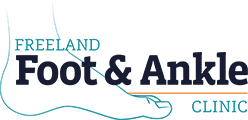You probably don’t give this much thought, but your feet are intricately structured—each one contains 26 bones, 33 joints, and over 100 different muscles, tendons, and ligaments! However, when you have an issue like a bunion or hammertoe, you are more likely to be aware of the abnormal structuring. Beyond awareness, you will want treatment to address symptoms and problems that arise from the condition.
When you need expert care for a bunion or hammertoe, you should come in and see Dr. Timothy Dailey here at Freeland Foot & Ankle Clinic. Dr. Dailey will assess the nature and severity of the toe deformity and then create a customized treatment plan for you.
What Is the Difference Between a Bunion and a Hammertoe?
Both bunions and hammertoes can be considered toe “deformities” because their form is atypical from what you would typically expect to see.
A bunion (hallux valgus) develops when the big toe begins to angle unnaturally at its metatarsophalangeal joint (MTP joint), where the toe connects to the foot. A bunion appears as a bony bump on the side of the foot and often causes pain while wearing shoes.
A hammertoe is a condition wherein a toe—usually the second or third toe—is curled in an unnatural fashion instead of being flat. If one or two of them don't budge when you flex your toes, you could be one of many patients suffering from hammertoes. The irregular curve of the toe can cause pain, calluses, and even sores. If the hammertoe is caused by a tight tendon under the affected toe, a minor procedure can be performed in-office to release the tendon and allow free movement of the toe.
In addition to their unusual appearances, both conditions can cause pain, discomfort, difficulty wearing shoes, and an increased risk of callusing. Bunions can often be reddened and swollen as well.
![Bunion Treatment in Freeland MI]() Toe Deformity Treatment
Toe Deformity Treatment
Whether you have a bunion or a hammertoe, it is best to identify the issue at the earliest opportunity. When left unaddressed, these issues can worsen over time. Conservative treatment at early stages can include better footwear choices, stretching and strengthening exercises, pain medication, night splints, and buddy taping.
Additionally, we may prescribe custom orthotics to rebalance pressure across your feet and address any existing gait problems that contribute to the bunion or hammertoes.
LEARN MORE: 9 Tips for Relieving Bunion Pain
When using conservative care, the goals are to stop the toe deformity from becoming worse and relieve any pain and discomfort you are experiencing. Since these conditions are irreversible, it is impossible to correct them without surgical intervention. If your condition causes severe pain and difficulty, we may recommend surgery to correct the affected toe(s). The good news is that advances in surgical techniques have made these surgeries less invasive, with quicker recovery periods than previously.
Professional Care for Bunions and Hammertoes
If you have developed either of these conditions, contact Dr. Dailey at Freeland Foot & Ankle Clinic to evaluate your toe deformity. He will determine why your toe has moved out of position and which type of treatment will be best for you. Give us a call at (989) 695-6788 or contact us online to schedule your appointment today.

 Toe Deformity Treatment
Toe Deformity Treatment